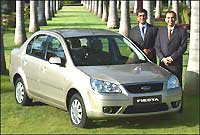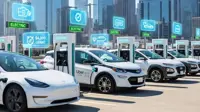Will the Fiesta double Ford''s fortunes?
15 Nov 2005
Ford India is banking on the Fiesta to double its sales. Given its aggressive pricing, the car may just help Ford hit the jackpot.
Ford India recently showcased its mid-sized model the Ford Fiesta, a three-box sedan, in India. The importance of the premium mid-sized Fiesta for Ford India can be gauged by the fact that Ford Motor Company's chairman and CEO William Clay Ford flew down to India for the launch.
Ford India's plant at Maraimalainagar, near Chennai, has a production capacity of one lakh units per annum working in three shifts, which is adequate to meet the increased demand. The company is banking on local content sourcing to price its cars competitively and claims to have achieved 75 per cent indigenisation in the Fiesta at the very outset of production, which has given the firm sufficient leeway to price it competitively.
The car has a locally made petrol engine and gearbox, while the turbo-diesel engine will be imported from Europe initially. This engine has been co-developed by Ford and Peugeot-Citroen of France. The Fiesta comes with 1.4 or 1.6-litre petrol engines or a 1.4-litre common rail diesel (CRD) engine, and is positioned in one of the highest-growth segments in the luxury car market in India.
Ford recently declared a loss in the last quarter in the US, and is banking on its Asia operations to provide the company a cushion in the future. In India, its hopes at present are riding on the Fiesta. Announcing the launch of the Fiesta last month, chairman and CEO Bill Ford said, "India is critical for the Ford Motor Company."
How critical is the Fiesta for Ford's Indian operations? For one, the company is banking on the Fiesta to double its sales to 50,000 units next year. V Sivaramakrishnan vice president, sales and marketing, Ford India, said at the global debut of the new Fiesta, "We will double our sales to 50,000 units next year. We are hopeful that the launch of the new premium car will help us increase our sales." The new car would enable Ford to compete more aggressively in the Indian market, he added.
The company has invested around $100 million in the new car, developed by Ford's global engineering and design team supported by a specialised team of Indian engineers. The company is also banking on the 'very high local content' in the new Fiesta to contribute to its growth in the C segment.
In 2005, Ford sold 24,000 units against 27,000 units last year. The company attributes its almost flat sales in India to the increase in input costs and fuel prices. It has invested around $470 million since it commenced operations in India.
What's worrisome for the company is that the sales of the Ikon, its best-selling model in India, have been slipping. The model was selling between 1,800 and 2,000 units a month till last year, mainly on the back of value-for-money editions like the Flair, priced below the Rs5-lakh mark. In the first half of the year, barring April 2005, Ikon's sales slipped by 24 per cent. In volume terms, this translates into a decline from 11,136 units sold between April and September 2004, to 8,515 units in the same period this year. This, when the total car market grew 11 per cent to 90,791!
Ford India's market share in the mid-size segment has declined to 9.38 per cent from 13.61 per cent and, in the overall car market, the company's share has declined to 2 per cent from 2.9 per cent in the first half of last year. During last fiscal ended March 2004, Ford India carried over an accumulated loss of Rs628.90 crore, according to the company's filing with the registrar of companies.
carried over an accumulated loss of Rs628.90 crore, according to the company's filing with the registrar of companies.
Apart from the Ikon, Ford's other models include the sports utility vehicle Endeavour, the Fusion, which has been positioned as an 'urban activity vehicle' and the premium Mondeo. The Mondeo sells in almost negligible numbers and in the past year its sales haven't registered more than 10 units per month. In some months it has even had zero sales. The Ford Endeavor sells around 300 to 325 units per month, though even that has been falling. Honda's popular model, Honda City, dominates the mid-size market with monthly volumes of between 3,200 and 3,400 units – twice what the Ford Ikon sells. The Hyundai Accent comes next, with a monthly volume of 1,800 to 2,000 units.
The Ikon sold well in the early and late '90s – up to almost 2,500 units a month. The company even added a second shift and hired an another 700 people to keep up with the increasing demand. It now faces intense heat from the Tata Indigo. New launches like the Hyundai Getz and price cuts by Maruti for the Baleno have worsened matters for Ford. The Ikon was a big success initially because of slick marketing and the car's performance, mainly the its excellent pick up, resulting from a high torque. But the 'Josh Machine', as it was advertised, is also a bit of a fuel guzzler with an average mileage of 7km to 9km per litre, a dampener in times of upwardly mobile fuel prices.
The Fusion, launched last December, has also turned out to be a non-starter. Though the Fusion is not placed in any particular segment – there being no other 'urban activity' vehicles – it faces competition from the Maruti Swift, the Hyundai Getz and even from the Tata Indigo Marina.
All in all, considering that so far Ford India does not have a small car in its Indian stables, it hasn't done too badly. Now, with the launch of the new Fiesta 1.4 litre petrol version starting at Rs5.59 lakh, it is hoping to give its flagging fortunes a major boost till it can come up with a real winner, probably a small car, in a few years. Other Fiesta variants include the 1.6 litre Zxi at Rs6.29 lakh and the 1.6 litre Sxi at Rs6.89 lakh. Its top-priced variant is the diesel CRD version with a 1.4 litre engine, at Rs6.99 lakh. At these prices, the lower end model competes with Maruti's Esteem, Opel's Corsa the Tata Indigo and Hyundai's Accent, while the higher end models compete with Maruti's Baleno and the Honda City.
Internationally rising fuel prices and rising competition have spurred Ford into developing small cars. The company has joined hands with Italy's Fiat for making small cars for the US and European markets that would help both the carmakers face the combined onslaught of the Japanese and Korean competition.
In the US, these small cars would replace older models like the Fiat 500 and the Ford KA. The joint venture would help the companies keep development costs down. Initially they are likely to be launched in the US, where Toyota is fast gathering market share at the cost of the big two in Detroit. It's a certainty that Ford's small cars will ultimately come to India, going by the popularity of small cars in the country. However, it is anyone's guess as to when that will happen.
Ford also seems to have decided to bring in the Fiesta a little late. David Freidman, the former managing director of Ford India admitted as much, saying, "Ford Motors has been going through a rough patch in the North America market, so it was a difficult time to look at making large new investments elsewhere. At the same time, competition has heated up in India and margins are being squeezed, so we've been deliberate about rolling out new models."
In the past few years the Indian market has become more competitive, and new launches are expected in the coming months. In addition, existing carmakers are expanding capacity keeping in view the fact that the market is growing at 10 to 15 per cent per annum.
Most carmakers, even small manufacturers, are adding capacity.
- Hyundai India has spent $450 to $500 million on a second plant next to its first one in Madras, which will take its total capacity to 400,000 cars per year by 2007.
- Honda is raising its annual capacity to 50,000 units from 30,000 by the end of 2005, at a cost of $33 million.
- General Motors has more than doubled the capacity in its Gujarat facility to 60,000 units at a cost of $69 million, and can step up to 80,000 units if required.
- Czech carmaker Skoda is also nearly doubling capacity in India, while German car makers BMW and Volkswagen are looking at setting up plants.
- French carmaker Renault is in a joint venture with Mahindra & Mahindra (M&M) to make the Logan sedan.
Apart from this there is competition from Indian car manufacturers, who are also exporting cars to other markets.
The decision to launch the Fiesta in India at this point of time raises a question mark. According to Arvind Mathew, managing director, Ford India, the Fiesta is a powerful brand name that is widely admired around the world. Also, success in the domestic market is very important for Ford's operations, as it is reporting flat exports of the Ikon to the Latin American and South African markets since last year.
The Fiesta was originally introduced in the '70s and has gone through six redesigns. A small car by American standards - its hatchback version available in Europe is slightly larger than Zen or the Santro - the three box version of the Fiesta to be introduced in India is still smaller than the Corolla and the Elantra. Given its aggressive pricing, the Fiesta may just surprise its rivals. How it does in the showrooms will have to be seen.






.webp)















